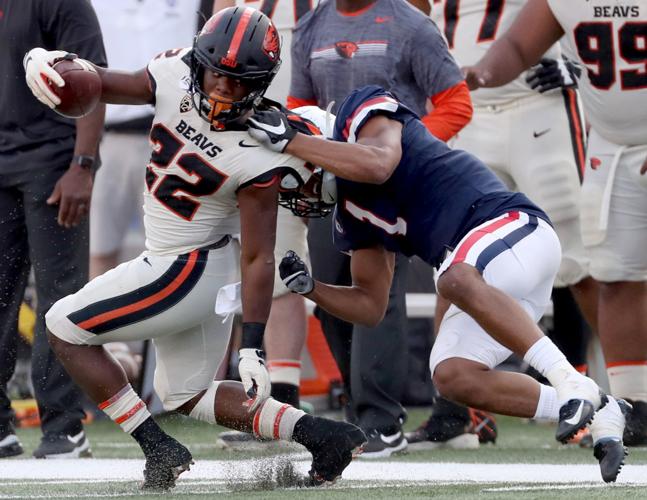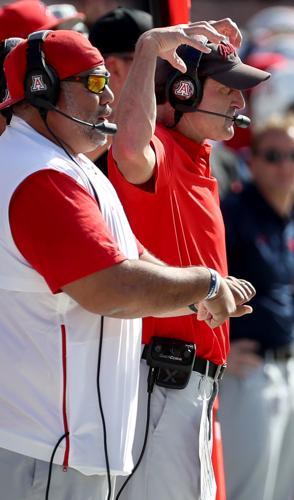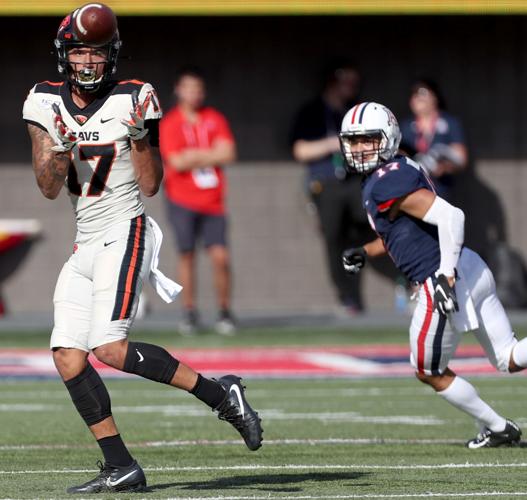Four policemen flanked Kevin Sumlin on his slow walk to Arizona’s locker room Saturday evening. Their grim faces told you as much as the scoreboard: Oregon State 56, Arizona 38.
A minute later, new UA defensive coordinator Chuck Cecil walked alone, literally and figuratively, across the end zone and into what has become the equivalent of football hell.
Who is going to help Cecil out of a coaching purgatory in which the players he inherited last week are a combination of too slow and too small, a roster lacking star-power — and with all of that about to collide with an unforgiving schedule that includes the league’s most dominant teams, Utah and Oregon?
Sumlin has protection; he has three more years and more than $5 million guaranteed. Cecil is day-to-day, as has become the plight of the continuing and sorry existence of Arizona football’s program.
Saturday’s announced attendance of 36,309 was the smallest homecoming crowd at Arizona Stadium since 1975, when the facility held just 40,000. It was the second-smallest crowd in any UA game in Tucson since 1997.
The old stadium was lifeless. Nor was there any visible energy on the UA sideline. Interest in Arizona football has diminished so greatly that the Wildcats have drawn fewer than 40,000 fans in three of its last four games.
That had never happened in Arizona’s 42 years in the Pac-12.
“When stuff like this happens,” said the real Pride of Arizona, stalwart running back J.J. Taylor, “a lot of people like to point fingers.”
But this time, the Wildcats can only point fingers at themselves.
After Oregon State scored to take a 14-6 lead in the second quarter, UA defensive players scattered on the sideline, taking seats by units — linemen, linebackers, defensive backs — from the 25-yard-line to the 45-yard line.
Their collective body language was that of a guy who had just finished a grueling graveyard shift at the mine. It was the same group that had yielded 133 points in three previous losses, leading to the firing of two assistant coaches.
Cecil commanded the defense to stand up and gather in a circle. He became animated, trying to find a spark, jumping up and down, chanting some team-unifying hosanna, demanding that his defensive unit do the same.
A few guys went through the motions of jumping. Others on the fringe just watched. The Wildcats had the look of a defeated team even though they were playing the league’s least-feared football program, Oregon State, a club that had gone 3-21 the last two seasons.
Forget Arizona’s costly taunting penalty, forget its damaging late-hit penalty, forget the botched point-after-touchdown attempts, forget that injuries to the offensive line forced seldom-used Steven Bailey, Jon Jacobs and Jordan Morgan to play much of crunch time, and forget the consecutive plays in which quarterback Khalil Tate held the ball too long and was sacked.
Arizona regressed Saturday, and after stumbling through losses to Stanford, Washington and USC that didn’t seem possible.
You could’ve called down Vince Lombardi, George Halas and Tom Landry from football heaven on Saturday and Arizona still wasn’t going to be able to beat the Beavers.
The onus of Saturday’s free-fall is on Sumlin. He spoke of injuries, of miscommunication with the new defensive sets, and he spoke of the lack of effort. A head coach is responsible for all of those things.
The three-game gauntlet that awaits — at Oregon, at home versus Utah and at ASU — will test Sumlin’s head coaching acumen at a level that he might never have experienced at Texas A&M and Houston.
The one thing he got right Saturday was his comment that Oregon State of 2019 looks a lot different from the Oregon State of 2018, when the Beavers were outscored by an average of 46-26, the widest disparity of all Power 5 conference schools.
“(OSU coach Jonathan Smith) is doing a great job,” said Sumlin. “He’s got a lot of different personnel than they had last year at this time. He’s done a good job of not giving things away.”
Those are the words an opposing coach needs to say about Arizona in 2020 if this restoration project, captained by Sumlin, is going to work out.
Over the last 20 years, Arizona has gone bust on a lot of Saturday afternoons. In 2011, the Wildcats fell to a 1-9 Colorado team that had lost seven straight games. In 2007, Arizona lost to a lower-tier New Mexico club that would go 4-8 and fire its coach. And in 2002, Arizona lost to a Stanford team that lost five straight and finished 2-9 after upsetting the Wildcats.
Saturday’s loss to Oregon State now belongs in that woeful company.
Returning home, playing a vulnerable opponent, changing defensive coaches and celebrating Dick Tomey’s Desert Swarm years on homecoming weekend should have been a recipe for progression.
Instead, the Wildcats are backpedaling and the community’s confidence in the direction of their football program erodes week by week.
Other than that, wasn’t it a nice autumn afternoon?







